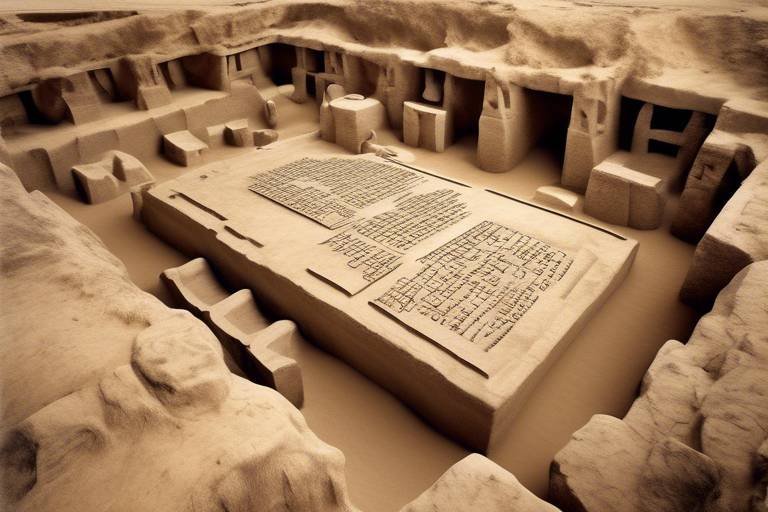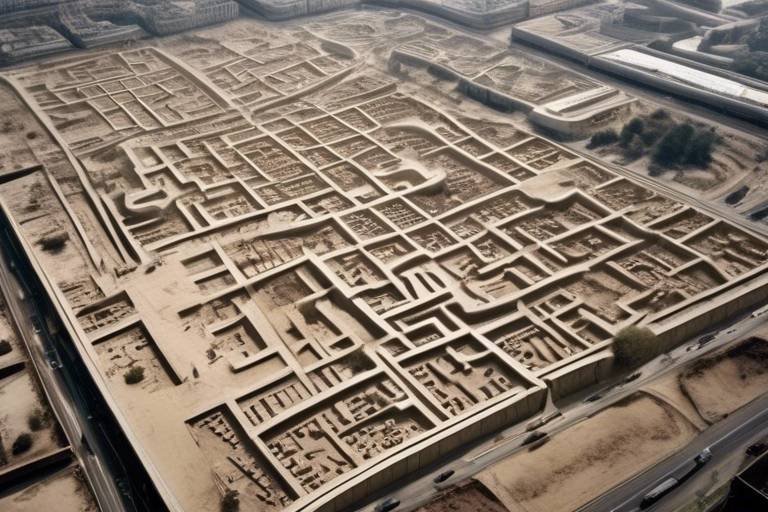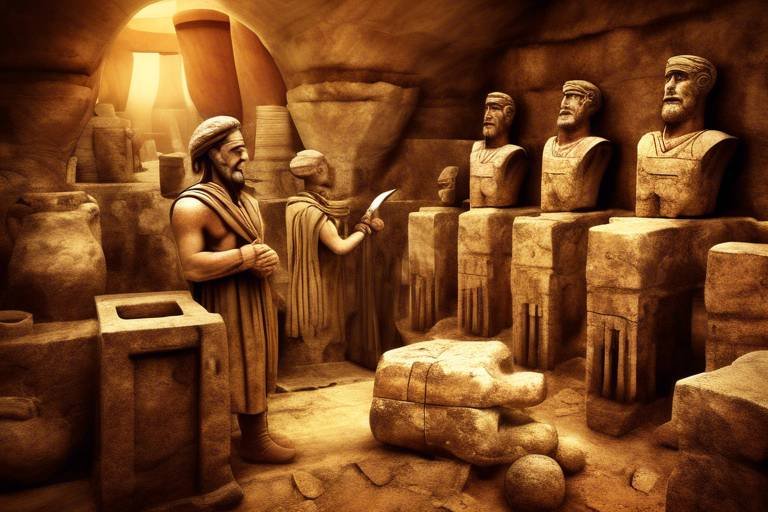The Future of Archaeology in the Digital Age
As we step into the digital age, the field of archaeology is experiencing a profound transformation, thanks to the integration of cutting-edge technologies. The marriage of archaeology and technology is not just a mere union; it is a dynamic synergy that is reshaping the way we explore, understand, and preserve ancient civilizations. The future of archaeology is being redefined by the innovative tools and methods that are revolutionizing traditional practices and opening new frontiers of discovery.

Virtual Reality Applications
Virtual Reality (VR) applications have revolutionized the field of archaeology by offering immersive experiences that transport researchers and the public back in time to ancient civilizations. Through the use of VR technology, archaeological sites are recreated in stunning detail, allowing users to explore historical landscapes and structures as if they were physically present. This innovative approach not only enhances the understanding of past cultures but also provides a unique way to engage with history.
Imagine walking through the majestic ruins of an ancient city, witnessing daily life unfold before your eyes, all from the comfort of your own home. VR applications in archaeology make this possible, offering a glimpse into the past that was previously unimaginable. Researchers can use VR to conduct virtual excavations, study artifacts up close, and reconstruct ancient environments with remarkable accuracy.
Moreover, VR technology enables the preservation of fragile archaeological sites by creating digital replicas that can be shared and explored by future generations. It bridges the gap between the past and the present, allowing for a more interactive and dynamic approach to studying history. As VR continues to evolve, its potential to transform archaeological research and education is limitless.

LiDAR Technology Advancements
Exploring how technology is revolutionizing archaeological practices and research methods, shaping the field's future direction and potential impact on preserving and understanding ancient civilizations.
Utilizing VR to recreate ancient sites, allowing researchers and the public to experience historical landscapes and structures in immersive ways.
LiDAR technology has brought about significant advancements in the field of archaeology. By utilizing Light Detection and Ranging technology, researchers can now uncover hidden archaeological features that were previously inaccessible. LiDAR scanning has the capability to penetrate dense vegetation and urban areas with unprecedented precision, revealing ancient structures and landscapes that have long been forgotten or obscured. This technology has revolutionized the way archaeological sites are discovered and studied, providing a new level of detail and accuracy that was unimaginable in the past.
Discussing the role of machine learning algorithms in automating artifact classification, dating, and interpretation processes, enhancing efficiency and accuracy in archaeological investigations.
Exploring how 3D printing is enabling the replication of delicate artifacts for research, education, and public engagement while preserving the originals.
Highlighting the benefits of open-access archaeological databases and collaborative platforms in facilitating data sharing, interdisciplinary research, and global knowledge exchange.
Examining the use of AR tools during archaeological fieldwork for real-time data visualization, interpretation, and site documentation, enhancing on-site analysis and decision-making.
Addressing the ethical and practical challenges of digitally preserving archaeological data, including issues of data security, authenticity, and long-term accessibility.
Exploring how blockchain technology can ensure the traceability and authenticity of archaeological artifacts, combating looting and illegal trade in cultural heritage items.
Stay tuned for the Frequently Asked Questions section which will provide answers to common queries about the future of archaeology in the digital age.

Machine Learning in Artifact Analysis
Exploring how technology is revolutionizing archaeological practices and research methods, shaping the field's future direction and potential impact on preserving and understanding ancient civilizations.
Utilizing VR to recreate ancient sites, allowing researchers and the public to experience historical landscapes and structures in immersive ways.
Examining how LiDAR scanning is transforming the discovery of hidden archaeological features beneath dense vegetation or urban areas with unprecedented precision.
Machine learning algorithms play a vital role in automating artifact classification, dating, and interpretation processes in archaeology. By analyzing vast amounts of data, these algorithms can identify patterns and trends that may not be immediately apparent to human researchers. This automation not only enhances the efficiency of archaeological investigations but also improves the accuracy of artifact analysis, leading to more insightful discoveries.
Exploring how 3D printing technology is revolutionizing the field of archaeology by allowing the replication of delicate artifacts. Researchers can create precise replicas of ancient objects for further study, education, and public engagement while ensuring the preservation of the originals.
Highlighting the benefits of open-access archaeological databases and collaborative platforms in facilitating data sharing, interdisciplinary research, and global knowledge exchange.
Augmented reality tools are transforming archaeological fieldwork by providing real-time data visualization, interpretation, and site documentation. Archaeologists can overlay digital information onto physical excavation sites, enhancing their understanding of the surroundings and making informed decisions on the spot.
Addressing the ethical and practical challenges of digitally preserving archaeological data, including issues of data security, authenticity, and long-term accessibility.
Exploring how blockchain technology can ensure the traceability and authenticity of archaeological artifacts, combating looting and illegal trade in cultural heritage items.
Stay tuned for the FAQ section!

3D Printing for Artifact Replication
3D printing technology has revolutionized the way archaeologists approach artifact replication. By harnessing the power of 3D printers, researchers can create exact replicas of delicate and intricate artifacts with remarkable precision. This advancement not only aids in preserving the originals by minimizing handling but also opens up new possibilities for research, education, and public engagement.
Imagine being able to hold a replica of an ancient artifact in your hands, feeling its texture and intricacies, without risking damage to the original piece. 3D printing allows for the recreation of artifacts that are too fragile to be handled or displayed, making them more accessible to researchers and the general public. Additionally, these replicas serve as valuable teaching tools, enabling students and enthusiasts to explore history in a tangible and interactive way.
Furthermore, 3D printing facilitates collaboration among archaeologists and experts from various fields. By sharing digital models of artifacts, researchers can work together to analyze, study, and even improve upon the replicas. This collaborative approach not only enhances the accuracy of replication but also fosters a deeper understanding of ancient civilizations and their material culture.

Open Access Databases and Collaboration
Exploring how technology is revolutionizing archaeological practices and research methods, shaping the field's future direction and potential impact on preserving and understanding ancient civilizations.
Utilizing VR to recreate ancient sites, allowing researchers and the public to experience historical landscapes and structures in immersive ways.
Examining how LiDAR scanning is transforming the discovery of hidden archaeological features beneath dense vegetation or urban areas with unprecedented precision.
Discussing the role of machine learning algorithms in automating artifact classification, dating, and interpretation processes, enhancing efficiency and accuracy in archaeological investigations.
Exploring how 3D printing is enabling the replication of delicate artifacts for research, education, and public engagement while preserving the originals.
Highlighting the benefits of open-access archaeological databases and collaborative platforms in facilitating data sharing, interdisciplinary research, and global knowledge exchange.
Examining the use of AR tools during archaeological fieldwork for real-time data visualization, interpretation, and site documentation, enhancing on-site analysis and decision-making.
Addressing the ethical and practical challenges of digitally preserving archaeological data, including issues of data security, authenticity, and long-term accessibility.
Exploring how blockchain technology can ensure the traceability and authenticity of archaeological artifacts, combating looting and illegal trade in cultural heritage items.
Stay tuned for answers to common queries about the future of archaeology in the digital age.

Augmented Reality Fieldwork
Augmented Reality (AR) has emerged as a groundbreaking tool in the realm of archaeological fieldwork, revolutionizing how researchers interact with excavation sites and artifacts. By overlaying digital information onto the physical environment, AR enhances the on-site analysis process, providing real-time data visualization and interpretation capabilities. Imagine wearing AR glasses that not only show you the current view but also superimpose historical reconstructions, artifact details, and excavation data directly onto the landscape before you. It's like peering through a window into the past, allowing archaeologists to make informed decisions and gain deeper insights into the archaeological record.
One of the key advantages of using AR in fieldwork is its ability to facilitate collaborative efforts among archaeologists and experts from various disciplines. By sharing a common augmented reality environment, team members can simultaneously view and discuss findings, interpretations, and hypotheses in a dynamic and interactive way. This collaborative approach fosters a deeper understanding of the archaeological context and encourages interdisciplinary dialogue, leading to more comprehensive and nuanced interpretations of the past.
Moreover, AR technology enables the seamless documentation of excavation processes and findings, enhancing the accuracy and efficiency of data recording in the field. Through AR-powered tools, researchers can digitally annotate excavation areas, mark artifact locations, and create virtual 3D models of archaeological features in real time. This digital documentation not only streamlines the data collection process but also serves as a valuable resource for further analysis, publication, and public outreach initiatives.
Furthermore, the immersive nature of augmented reality fieldwork experiences opens up new possibilities for engaging the public in archaeological research and heritage preservation efforts. By developing AR applications for educational purposes, museums, cultural institutions, and archaeological sites can offer visitors interactive and informative experiences that bring the past to life. Imagine exploring a reconstructed ancient city through your smartphone or tablet, with AR overlays providing historical context, multimedia content, and interactive storytelling elements that captivate and educate audiences of all ages.
In conclusion, augmented reality fieldwork represents a transformative approach to archaeological practice, blending cutting-edge technology with traditional excavation methods to unlock the mysteries of the past in innovative ways. By harnessing the power of AR tools, archaeologists can enhance their fieldwork capabilities, collaborate more effectively, document findings with precision, and engage the public in the fascinating journey of discovery through time.

Digital Preservation Challenges
The digital age has opened up a realm of possibilities for archaeology, bringing with it a wave of technological advancements that are reshaping the way we study and preserve ancient civilizations. However, along with these innovations come a unique set of challenges in digitally preserving archaeological data. As we delve deeper into the digital realm, we must confront the ethical and practical hurdles that come with safeguarding this invaluable information for future generations.
One of the primary challenges in digital preservation is ensuring the security of archaeological data. With the vast amount of information now stored in digital formats, protecting this data from cyber threats and unauthorized access is paramount. Implementing robust security measures and encryption protocols is essential to prevent data breaches and ensure the integrity of archaeological records.
Another key issue in digital preservation is maintaining the authenticity of archaeological data over time. As technology evolves rapidly, ensuring the long-term accessibility and usability of digital archives poses a significant challenge. It is vital to establish standards and best practices for data storage, metadata documentation, and file formats to guarantee the continued authenticity and reliability of archaeological information.
Furthermore, the sheer volume of archaeological data being generated in the digital age presents a logistical challenge in terms of storage and management. Archaeological projects produce vast amounts of data, including images, maps, reports, and 3D models, all of which need to be organized, cataloged, and archived effectively. Developing efficient data management strategies and scalable storage solutions is essential to prevent data loss and ensure the preservation of valuable archaeological resources.
Moreover, the issue of data curation and metadata quality poses a significant challenge in digital preservation. Ensuring that archaeological data is properly curated, documented, and annotated is crucial for its long-term usability and interpretability. Establishing standardized metadata schemas and data curation practices can enhance the discoverability and accessibility of archaeological information, facilitating interdisciplinary research and knowledge exchange.
In conclusion, while the digital age offers unprecedented opportunities for archaeological research and preservation, it also presents unique challenges in safeguarding and managing archaeological data. By addressing issues such as data security, authenticity, storage, and curation, archaeologists can navigate the complexities of digital preservation and ensure the longevity of our cultural heritage in the digital realm.

Blockchain for Artifact Provenance
Blockchain technology is revolutionizing the way we track and verify the provenance of archaeological artifacts. By utilizing a decentralized and secure digital ledger, blockchain offers a transparent and tamper-proof system for recording the history and ownership of ancient objects. This innovative approach ensures the authenticity of artifacts by providing a verifiable trail of their journey from excavation to display.
Through blockchain, each artifact can be assigned a unique digital identity, allowing researchers and collectors to trace its origins and ownership history with confidence. This not only helps in combating the illicit trade of cultural heritage items but also safeguards against the circulation of counterfeit or stolen artifacts in the market.
Furthermore, blockchain technology enables stakeholders in the archaeological community to collaborate more effectively in verifying the authenticity and provenance of artifacts. By sharing encrypted and immutable data on a decentralized network, researchers, museums, and authorities can collectively ensure the integrity of cultural heritage objects and prevent their illegal trafficking.
Frequently Asked Questions
- What are the benefits of using Virtual Reality in archaeology?
Virtual Reality allows researchers and the public to explore ancient sites in immersive ways, providing a unique experience of historical landscapes and structures without physically being there. It enhances understanding and engagement with the past.
- How does LiDAR technology contribute to archaeological discoveries?
LiDAR scanning enables the detection of hidden archaeological features beneath dense vegetation or urban areas with high precision, revolutionizing the way researchers uncover ancient sites and structures that were previously difficult to access.
- What role does machine learning play in artifact analysis?
Machine learning algorithms automate artifact classification, dating, and interpretation processes, improving the efficiency and accuracy of archaeological investigations. This technology streamlines data analysis and enhances research outcomes.
- How does 3D printing benefit archaeological research?
3D printing allows for the replication of delicate artifacts, facilitating research, education, and public engagement while preserving the originals. It offers a hands-on approach to studying ancient objects and promotes accessibility to cultural heritage.
- What are the advantages of open-access archaeological databases?
Open-access databases promote data sharing, interdisciplinary collaboration, and global knowledge exchange in archaeology. Researchers can access and contribute to a wealth of information, fostering innovation and comprehensive research.
- How does Augmented Reality enhance archaeological fieldwork?
Augmented Reality tools provide real-time data visualization, interpretation, and site documentation during archaeological fieldwork, improving on-site analysis and decision-making processes. It offers a dynamic and interactive approach to studying archaeological sites.
- What challenges are associated with digital preservation in archaeology?
Digital preservation poses ethical and practical challenges related to data security, authenticity, and long-term accessibility of archaeological data. Ensuring the integrity and sustainability of digital records is crucial for preserving cultural heritage.
- How can blockchain technology help in ensuring artifact provenance?
Blockchain technology offers a secure and transparent method for tracking the provenance of archaeological artifacts, combating looting and illegal trade in cultural heritage items. It provides a reliable system for verifying the authenticity and ownership history of artifacts.



















